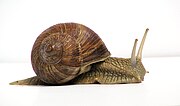Groups of animals
[edit]Porifera
The sponges (Porifera) were long thought to have diverged from other animals early. As mentioned above, they lack the complex organization found in most other phyla. Their cells are differentiated, but in most cases not organized into distinct tissues. Sponges are sessile and typically feed by drawing in water through pores. Archaeocyatha, which have fused skeletons, may represent sponges or a separate phylum. However, a phylogenomic study in 2008 of 150 genes in 21 genera[11] revealed that it is the Ctenophora or comb jellies which are the basal lineage of animals, at least among those 21 phyla. The authors speculate that sponges—or at least those lines of sponges they investigated—are not so primitive, but may instead be secondarily simplified.
Among the other phyla, the Ctenophora and the Cnidaria, which includes sea anemones, corals, andjellyfish, are radially symmetric and have digestive chambers with a single opening, which serves as both the mouth and the anus. Both have distinct tissues, but they are not organized into organs. There are only two main germ layers, the ectoderm and endoderm, with only scattered cells between them. As such, these animals are sometimes called diploblastic. The tiny Placozoans are similar, but they do not have a permanent digestive chamber.
The remaining animals form a monophyletic group called the Bilateria. For the most part, they are bilaterally symmetric, and often have a specialized head with feeding and sensory organs. The body is triploblastic, i.e. all three germ layers are well-developed, and tissues form distinct organs. The digestive chamber has two openings, a mouth and an anus, and there is also an internal body cavity called a coelom or pseudocoelom. There are exceptions to each of these characteristics, however - for instance adultechinoderms are radially symmetric, and certain parasitic worms have extremely simplified body structures.
Genetic studies have considerably changed our understanding of the relationships within the Bilateria. Most appear to belong to two major lineages: the Deuterostomes and Protostomes, which includes the Ecdysozoa, Platyzoa, and Lophotrochozoa. In addition, there are a few small groups of bilaterians with relatively similar structure that appear to have diverged before these major groups. These include theAcoelomorpha, Rhombozoa, and Orthonectida. The Myxozoa, single-celled parasites that were originally considered Protozoa, are now believed to have developed from the Bilateria as well.
[edit]Deuterostomes
Deuterostomes differ from the other Bilateria, called protostomes, in several ways. In both cases there is a complete digestive tract. However, in protostomes the initial opening (the archenteron) develops into the mouth, and an anus forms separately. In deuterostomes this is reversed. In most protostomes, cells simply fill in the interior of the gastrula to form the mesoderm, called schizocoelous development, but in deuterostomes it forms through invagination of the endoderm, called enterocoelic pouching. Deuterostomes also have a dorsal, rather than a ventral, nerve chord and their embryos undergo different cleavage.
All this suggests the deuterostomes and protostomes are separate, monophyletic lineages. The main phyla of deuterostomes are the Echinodermata and Chordata. The former are radially symmetric and exclusively marine, such as starfish, sea urchins, and sea cucumbers. The latter are dominated by the vertebrates, animals with backbones. These include fish, amphibians, reptiles, birds, and mammals.
In addition to these, the deuterostomes also include the Hemichordata or acorn worms. Although they are not especially prominent today, the important fossil graptolites may belong to this group.
The Chaetognatha or arrow worms may also be deuterostomes, but more recent studies suggest protostome affinities.
[edit]Ecdysozoa
The Ecdysozoa are protostomes, named after the common trait of growth by moulting or ecdysis. The largest animal phylum belongs here, the Arthropoda, including insects, spiders, crabs, and their kin. All these organisms have a body divided into repeating segments, typically with paired appendages. Two smaller phyla, the Onychophora and Tardigrada, are close relatives of the arthropods and share these traits.
The ecdysozoans also include the Nematoda or roundworms, the second largest animal phylum. Roundworms are typically microscopic, and occur in nearly every environment where there is water. A number are important parasites. Smaller phyla related to them are the Nematomorpha or horsehair worms, and the Kinorhyncha, Priapulida, and Loricifera. These groups have a reduced coelom, called a pseudocoelom.
The remaining two groups of protostomes are sometimes grouped together as the Spiralia, since in both embryos develop with spiral cleavage.
[edit]Platyzoa
The Platyzoa include the phylum Platyhelminthes, the flatworms. These were originally considered some of the most primitive Bilateria, but it now appears they developed from more complex ancestors.[12]
A number of parasites are included in this group, such as the flukes and tapeworms. Flatworms areacoelomates, lacking a body cavity, as are their closest relatives, the microscopic Gastrotricha.[13]
The other platyzoan phyla are mostly microscopic and pseudocoelomate. The most prominent are theRotifera or rotifers, which are common in aqueous environments. They also include the Acanthocephala or spiny-headed worms, the Gnathostomulida, Micrognathozoa, and possibly the Cycliophora.[14] These groups share the presence of complex jaws, from which they are called the Gnathifera.
[edit]Lophotrochozoa
The Lophotrochozoa include two of the most successful animal phyla, the Mollusca and Annelida.[15][16]The former, which is the second-largest animal phylum, includes animals such as snails, clams, andsquids, and the latter comprises the segmented worms, such as earthworms and leeches. These two groups have long been considered close relatives because of the common presence of trochophore larvae, but the annelids were considered closer to the arthropods,[17] because they are both segmented. Now this is generally considered convergent evolution, owing to many morphological and genetic differences between the two phyla.[18]
The Lophotrochozoa also include the Nemertea or ribbon worms, the Sipuncula, and several phyla that have a fan of cilia around the mouth, called a lophophore.[19] These were traditionally grouped together as the lophophorates.[20] but it now appears they are paraphyletic,[21] some closer to the Nemertea and some to the Mollusca and Annelida.[22][23] They include the Brachiopoda or lamp shells, which are prominent in the fossil record, the Entoprocta, the Phoronida, and possibly the Bryozoa or moss animals.[24]






No comments:
Post a Comment